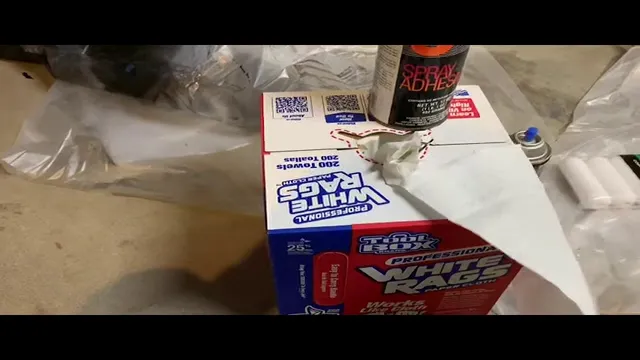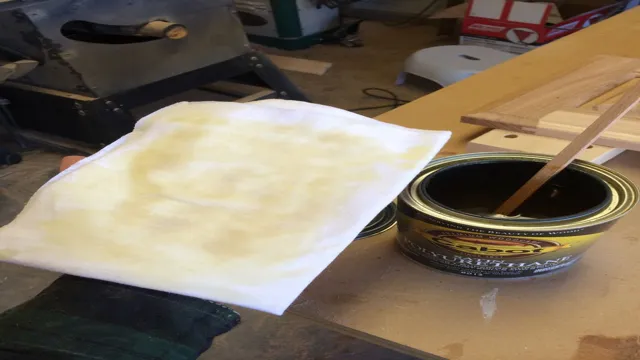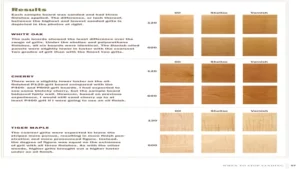Have you ever tried your hand at DIY projects and wondered how to create your own tack cloth? Tack cloth, also known as tack rag, is used to clean surfaces before painting or staining to prevent dust and debris from ruining your project. Although readily available at most hardware stores, making your own tack cloth can save you money and allow you to customize its size and texture. In this step-by-step guide, we will walk you through the process of creating your own DIY tack cloth using simple materials that you likely already have on hand.
Whether you are a seasoned DIYer or just starting out, creating your own tack cloth is a useful skill to have in your toolkit. So let’s dive in and learn how to make your own DIY tack cloth today!
Introduction
Making a tack cloth is an easy task that can be done within minutes. A tack cloth is a sticky cloth used in woodworking and painting to remove dust and debris from surfaces before painting or applying a coating. To make a tack cloth, you will need a lightweight cotton cloth, a container with a lid, and some mineral spirits.
Firstly, cut the cotton cloth into a manageable size and place it in a container. Then, pour a small amount of mineral spirits into the container. Make sure the cloth is fully submerged in the solution and let it soak for a couple of minutes.
After it has soaked, carefully wring the cloth to remove any excess liquid. Finally, hang the cloth to dry for a couple of hours. Your tack cloth is now ready for use.
With this simple process, you can save yourself the expense of buying tack cloth and create a reusable tack cloth that saves you money in the long run.
Explaining what a tack cloth is and why it’s important for woodworking and painting.
Are you a woodworking or painting enthusiast? If so, you may have heard of a tack cloth. A tack cloth is an essential tool in both woodworking and painting that helps ensure a clean finish. It is a soft cloth that has been treated with a sticky substance that removes dust and other particles from the surface of the material being worked on.
The tack cloth helps ensure that the surface is free from dust and debris that could affect the quality of the finish. Think of it like using a lint roller to remove pet hair from your clothes – a tack cloth does the same thing for your woodworking and painting projects! So next time you’re working on a project, reach for a tack cloth and see the difference it can make.

Materials Needed
If you happen to be a DIY enthusiast or someone who enjoys woodworking, then a tack cloth is a necessary item to have on your list of materials. Not only is it easy to make, but it also helps to remove fine surface dust, providing a smooth and clean finish on your project. The materials needed include cheesecloth, beeswax, and mineral spirits.
Cut the cheesecloth into manageable sizes, and melt the beeswax in a double boiler while adding mineral spirits to thin it down. Once melted, dip the cheesecloth into the mixture, squeeze any excess liquid, and let it dry overnight. Once dry, your tack cloth is ready to use.
Use it to wipe down any surface to be painted, varnished, or stained. The tacky surface will pick up any remnants of dust, ensuring a flawless finish. Making a tack cloth is a simple and cost-effective method to make your projects turn out professional-looking.
List of materials needed and their purpose in the process.
When it comes to any manufacturing process, having the right materials is crucial for a successful outcome. The same principle applies to jewelry making, where the right materials can make a huge difference in the final product. Some of the most common materials used in jewelry making include precious and semi-precious gemstones such as diamonds, rubies, sapphires, emeralds, and turquoise, among others.
Metals such as gold, platinum, silver, and brass are also essential. Design elements such as clasps, chains, bezels, and findings are crucial for any piece of jewelry. In addition, tools such as pliers, cutters, tweezers, and wire cutters are essential for jewelry making.
While the cost of materials will vary depending on the type and quality, investing in high-quality materials can lead to stunning pieces that will last a lifetime. Whether you are a beginner or an experienced jewelry maker, having the right materials will help ensure that your creations are both beautiful and durable.
Step 1: Cut the Fabric
To make a tack cloth, the first step is to cut the fabric. You’ll need a piece of cotton or cheesecloth that is about one foot by one foot. Cut the fabric so that it’s easily manageable to work with, but not so small that it won’t effectively pick up debris from your project surface.
A larger cloth can be folded and used for multiple applications. Keep in mind that the fabric should be high-quality and free of any loose threads or debris before cutting. Once you have your fabric cut, you’re ready to move onto the next step in the process of making your own tack cloth.
Remember, a good tack cloth can make all the difference in achieving a clean, smooth surface on your painting or woodworking project. With just a few simple steps, you can make a tack cloth that will help you achieve professional results without breaking the bank.
Procedure for measuring and cutting the cheesecloth to size.
Cutting cheesecloth to size is an essential step in many recipes, including those that involve straining liquids, making cheese, or even crafting. However, many people struggle with this simple task, making it more complicated than it needs to be. To start, gather a pair of sharp scissors and the cheesecloth roll, making sure that the fabric is clean and free of any dirt or debris.
Then, decide on the size of the cloth you need, either by measuring the container you will be using or by estimating the necessary length based on your recipe’s instructions. Next, cut the cheesecloth roll into the desired size, using the scissors to make straight lines without fraying the fabric’s edges. Be sure to cut enough cheesecloth to allow for easy handling and wrapping if necessary.
By following these steps, you will be able to cut the cheesecloth to the perfect size for your recipe or craft project, ensuring excellent results every time. So, whether you’re making cheese, filtering liquids, or creating a decoration, start by mastering the art of cutting cheesecloth to size.
Step 2: Soak in Solvent
Now that you have prepared your fabric for your homemade tack cloth, it’s time for Step 2: Soak in Solvent. A good solvent option is mineral spirits, which can be found in most hardware or home improvement stores. Pour the solvent into a container that will hold your fabric and let it soak for a few minutes.
Make sure the fabric is fully submerged and that it absorbs the solvent. After soaking, gently wring out any excess solvent and hang the fabric to dry. If you are concerned about any leftover solvent, you can rinse the fabric with water and let it dry again before moving on to the next step.
The solvent will help to remove any remaining dust or debris that may have settled on the fabric during storage or handling. With a clean and fully soaked fabric, your homemade tack cloth will be ready for use!
Explanation for selecting the proper solvent for the project and steps for saturating the fabric.
When selecting the proper solvent for your fabric project, it’s essential to consider the type of fabric you’re working with and the desired outcome. You want to choose a solvent that will not damage the fabric and is effective in achieving your intended result. Once you have your solvent selected, it’s time to move on to the next step: soaking the fabric.
To saturate the fabric properly, you will need a large bowl or basin to hold the solvent. Gently place the fabric into the solvent and press it down until it’s fully submerged. You may need to stir the fabric around a bit to ensure it’s entirely saturated with the solvent.
It’s important to note that different fabrics will require different soaking times. Be sure to read the instructions on the solvent’s bottle carefully and follow the recommended soaking time. You don’t want to over-saturate the fabric, as this can lead to discoloration or damage.
After the fabric has soaked for the recommended time, carefully remove it from the solvent and gently wring out any excess. Be sure not to twist or wring the fabric too aggressively, as this can also cause damage. Overall, selecting the proper solvent for your fabric project and soaking the fabric correctly is vital to achieve a successful outcome.
Take the time to research and read instructions carefully to ensure your project’s success.
Step 3: Squeeze out Excess Solvent
Once you have successfully dipped your cheesecloth in the solvent of choice, it is essential to make sure that you squeeze out any excess. This step is crucial because it ensures that the tack cloth is not too saturated with the solvent, as this can lead to streaks or even splotches on your finished surface. Additionally, a tack cloth that is too wet can potentially transfer the solvent onto other surfaces accidentally.
The best way to squeeze out any excess liquid is by firmly gripping the cloth on both sides and wringing it out like a wet towel. This will remove any excess solvent while still allowing the cloth to effectively pick up any loose debris or dust particles from your surface. Remember that the goal is to make a tack cloth that is lightly moistened, not saturated, so take your time with this step to achieve the best results.
Tips for effectively removing the excess solvent from the fabric.
When it comes to removing excess solvent from fabric, the third step is crucial for a successful outcome. Squeezing out the excess solvent requires a delicate touch to avoid any damage to the fabric. One effective method is to lay the fabric flat on a clean surface and place a dry towel on top.
Gently press down on the towel, allowing it to absorb any remaining solvent. This process may need to be repeated multiple times until all excess solvent has been removed. It’s important to be patient during this step as rushing could cause the solvent to spread further into the fabric.
By taking the time to properly squeeze out the excess solvent, you’ll be left with a clean and fresh piece of fabric ready for its next use.
Step 4: Allow to Dry
Once you’ve completed Step 3 of making a tack cloth, the final step is to allow it to dry completely. This is crucial, as using the tack cloth while it’s still damp can cause more harm than good. The drying process can take a few hours, depending on the humidity level in your area.
To speed up the process, you can place the tack cloth in a well-ventilated area, or use a fan to circulate air. Once the tack cloth is completely dry, it’s ready for use. You’ll be amazed at how effective it is at picking up dust and debris, allowing you to achieve a beautifully smooth surface before painting or staining.
So next time you’re in need of a tack cloth, why not try making your own using this simple method?
Details on drying time and method.
When it comes to drying your freshly painted surface, timing is key. The drying time will depend on a variety of factors, such as the humidity and temperature of the room, the type of paint used, and the thickness of the coat. It’s important to follow the manufacturer’s instructions to ensure that the paint properly adheres to the surface.
Generally, water-based paints will dry faster than oil-based paints. To allow proper drying, avoid trying to rush the process by turning up the heat or using a fan. This could result in the paint not drying evenly or drying too quickly, which can cause cracking or peeling later on.
It’s recommended that you wait at least 24 hours before touching the painted surface or adding another coat. Once the paint has had ample time to dry, it’s important to properly dispose of any paint brushes or rollers used in the process. Water-based paints can be cleaned with soap and water, while oil-based paints will require a solvent like mineral spirits.
Properly disposing of any leftover paint and empty paint cans is also important, as many areas have specific rules and regulations regarding hazardous waste. By properly allowing your paint to dry and disposing of the supplies, you can ensure a beautiful and long-lasting finish on your project.
Step 5: Fold and Store
Now that your handmade tack cloth is ready, it’s time to learn how to fold and store it properly. First, ensure that the tack cloth is completely dry before folding it. Next, fold the tack cloth into a small, neat square.
It’s important to avoid creasing the cloth as much as possible, as this can cause it to lose some of its sticky properties. Store the tack cloth in an airtight container or plastic bag to prevent it from picking up dust or debris between uses. You can also include a few drops of linseed oil or other similar substance in the container to help preserve the tackiness of the cloth.
By following these simple steps, you’ll be able to use your handmade tack cloth for many projects to come.
Final instructions for properly folding the tack cloth and storing it for future use.
After completing the task of wiping down the surface with the tack cloth, it’s time to properly fold it and store it for future use. Firstly, ensure that the tack cloth is completely dry before folding it. If it’s still damp, it can lead to mold growth and render it unusable.
The best way to fold a tack cloth is by folding it into quarters, then fold it again to form a square. It’s important to fold it carefully to avoid any damage or contamination. Finally, secure the tack cloth by placing it in a resealable plastic bag, ensuring that it’s airtight.
This will prevent any dust or debris from getting onto the tack cloth while also keeping it clean and safe for the next use. Remember, the tack cloth is a valuable tool in achieving a clean and polished finish, so it’s important to store it properly to ensure it lasts a long time.
Conclusion
In summary, making a tack cloth is a simple yet essential task for any DIY enthusiast or professional. With just a few household items, you can create a powerful tool that will help you achieve a smooth and flawless finish on your surfaces. So go ahead and try making your own tack cloth today, and let your creativity flow uninterrupted.
“
Wrapping up with a summary of the benefits of making your own tack cloth and how easy it is to do.
Now that your homemade tack cloth is ready, it’s time to fold and store it properly. Start by folding the cloth in half, then in half again, until you have a small, compact square. This will ensure that the tacky surface stays protected and doesn’t pick up any dirt or debris.
You can store your tack cloth in a resealable plastic bag or airtight container until you’re ready to use it. Making your own tack cloth has many benefits, including cost-effectiveness, customization, and eco-friendliness. Not only is it easy to make, but it also allows you to choose the material and size that best fits your needs.
Plus, using a homemade tack cloth eliminates the need for disposable, single-use products, reducing waste and promoting a more sustainable lifestyle. So why not give it a try? With just a few simple steps, you can have a reusable and effective tack cloth that will come in handy for all your DIY and home improvement projects.
FAQs
What materials are needed to make a tack cloth?
To make a tack cloth, you will need cheesecloth, turpentine, and linseed oil.
How do I prepare the materials for making a tack cloth?
Cut a piece of cheesecloth to the desired size and mix equal parts turpentine and linseed oil. Soak the cheesecloth in the mixture and allow it to fully saturate.
How do I use a tack cloth?
Simply unfold the tack cloth and wipe it over the surface to remove any dust or debris. Be sure to dispose of the tack cloth after use.
Can a tack cloth be reused?
No, a tack cloth is a one-time use product. Dispose of it properly after use.
Are there any safety precautions I should take when making or using a tack cloth?
Yes, make sure to wear gloves and work in a well-ventilated area when making the tack cloth mixture. When using the tack cloth, avoid inhaling the fumes from the turpentine and linseed oil mixture.
Can I make a tack cloth without turpentine?
Yes, you can make a tack cloth using mineral spirits instead of turpentine.
How long can I store a tack cloth before using it?
Tack cloths should be used as soon as possible after making them for best results. However, if stored properly in an airtight container, they can last for a few days.







